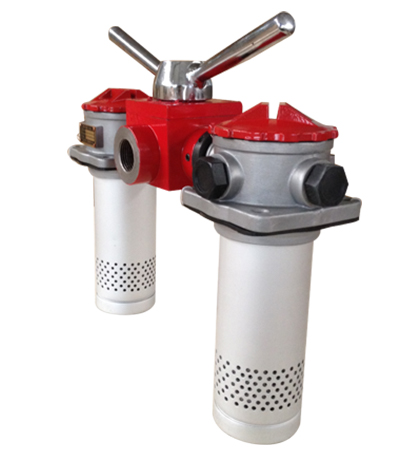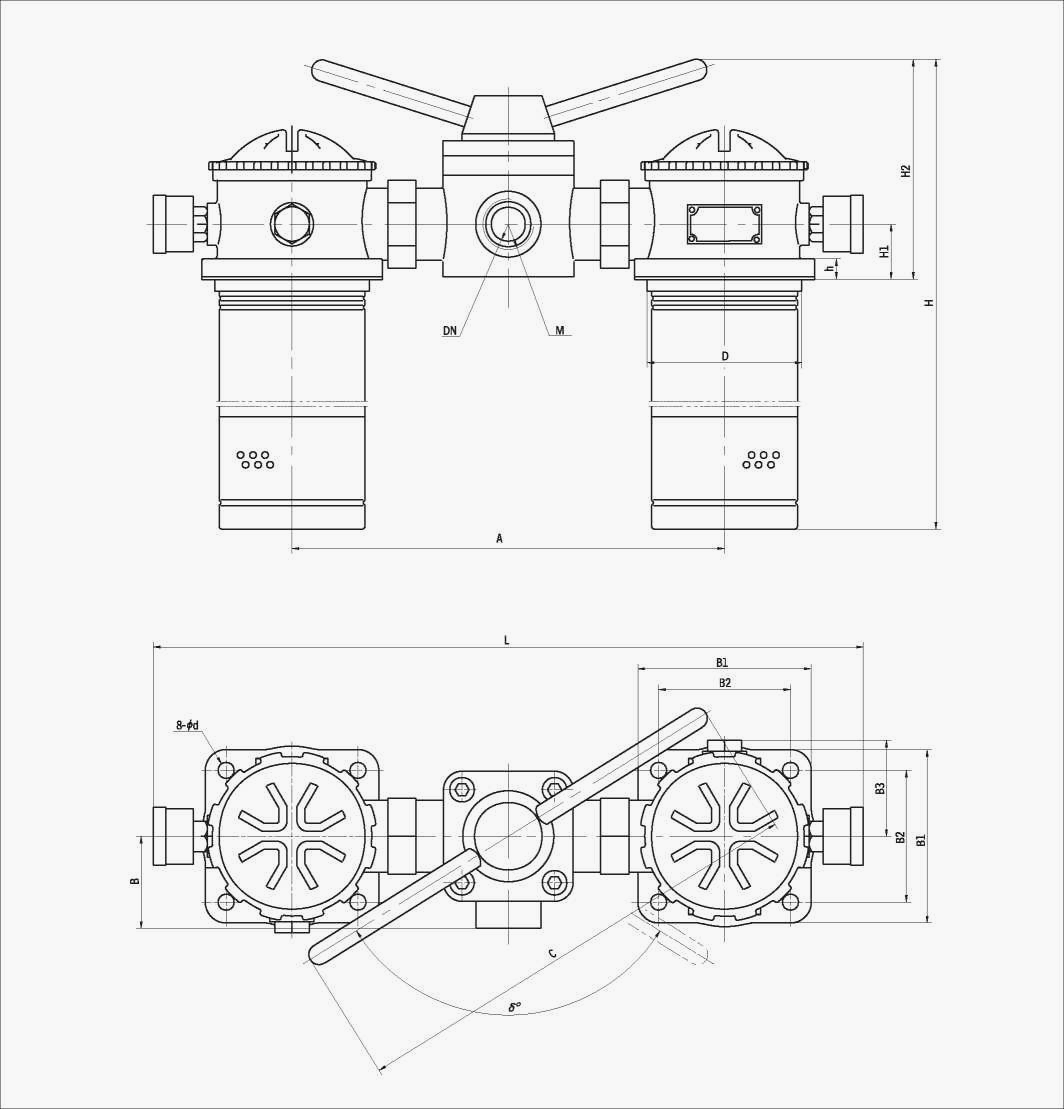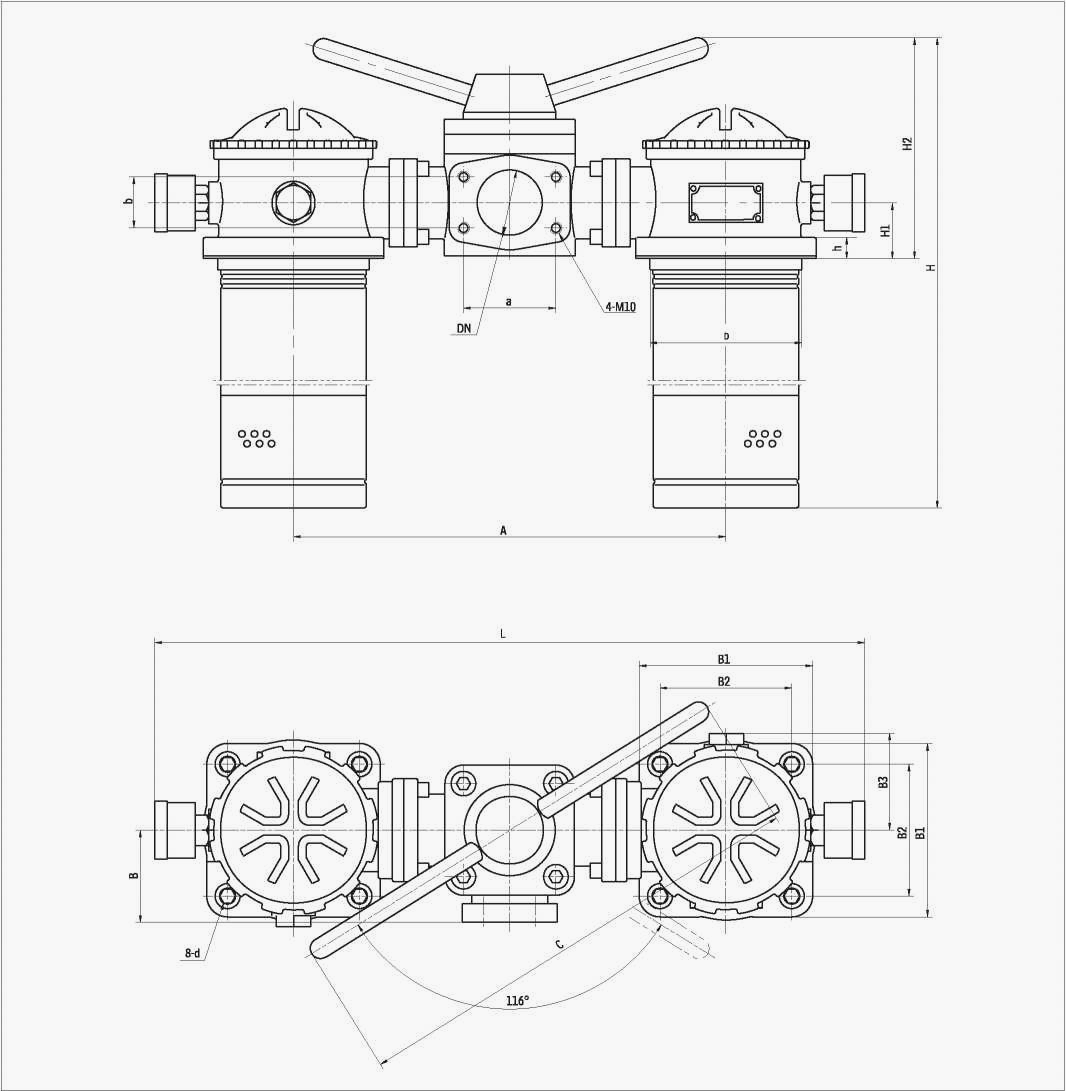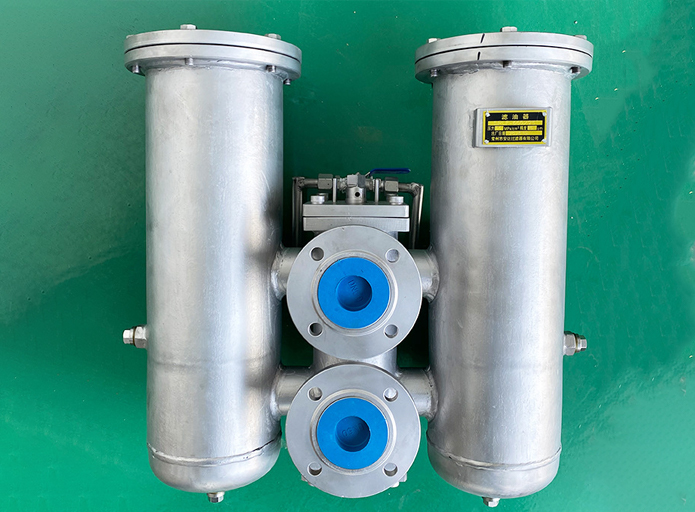The industrial scenario today demands performance-yielding, resource-saving, and operation-facilitating tools to ensure high productivity paired with low downtime. Recognizing this need, we present one of our flagship products, the SRFA series double barrel micro direct return oil filter, meticulously designed to meet the efficiency demands of modern industries.
Spanning across applications in machining operations, metallurgical, petrochemical, textile industry, electronics, and pharmaceutical processes, this filter brings high filtration accuracy, large oil capacity, and high pollutant carrying capacity under its wing.

The Essence of Design:
Embedded in the SRFA series' design lies the charm of its dual functionality. The filter comprises two single cylinder filters, a directional valve, by-pass valve, transmitter, and diffuser. This unique dual filter design elevates oil filtering efficiency, ensuring an uninterrupted and refined oil flow at all times. Installed on the oil tank's top, these filters can efficiently replace the filter element without stopping the system. Such convenience paired with high functionality is a rarity in the industry today.
Filtration Par Excellence:
The SRFA series double barrel micro direct return oil filter is designed to filter not just metal powders generated due to wear of various components in the hydraulic system but also rubber impurities from seals. This allows the filter to maintain a clean oil flow back into the oil tank, facilitating smooth oil circulation throughout the system.
In a situation where the filter element of a filter is blocked, leading to an inlet and outlet pressure difference of 0.35Mpa, the unit maintains high functionality. The transmitter sends a signal when the pressure difference is reached. Then, by switching the reversing valve, standby oil filtration starts, and the blocked filter element can then be replaced. This smart mechanism ensures high operational efficiency even under unexpected scenarios.
The filter is designed to handle heavy-duty applications, commonly found in heavy machinery, mining machinery, and metallurgical machinery. The SRFA’s ability to filter a range of mediums, including water and ethylene glycol in hydraulic oil, showcases its versatility and adaptability.
Unique Features and Convenience:
The design of the SRFA series double barrel micro direct return oil filter stands true to its objective of user convenience. In scenarios where there is a delay in replacing a blocked filter element, causing the differential pressure at the oil inlet and outlet to rise to 0.4MPa, the by-pass valve kicks into operation. This automatic mechanism ensures uninterrupted operation of the filter element and the system, making sure the filter doesn’t become a bottleneck in the production process.
The direct return oil filter facilitates easy replacement of the filter element and refueling of the oil tank. All it takes is to unscrew the filter cover, and the replacement or refueling can be done.
But the convenience doesn't stop here. The filter heads come equipped with two M18x15 oil port, which makes installing the transmitter effortless.
The Quality of Components:
The filter incorporates a diffuser at the bottom of the oil return cylinder that smoothens the transition of the oil return medium into the oil tank. This arrangement reduces the chances of bubble formation and re-entry of air, thereby minimizing the disturbance of deposited pollutants.
The SRFA series opts for a new type of chemical fiber filter material, standing out with several key benefits—high filtration precision, large oil passing capacity, minimal original pressure loss, and high pollutant holding capacity.
Offering filtration precision calibrated by the absolute filtration standard and a filtration ratio of β3,5,10,20≥200, it guarantees filtration efficiency of n≥99.5%. Thus, the SRFA series goes hand in hand with ISO standards, offering state-of-the-art filtering technology at your disposal.


Summary:
The SRFA series double barrel micro direct return oil filter is not just a product, but a solution to many industrial filtration challenges. Its unique design, high filtration accuracy, adaptability, user convenience, and high functionality make it a worthy inclusion in varied industries. Its compliance with global ISO standards emphasizes its commitment towards quality and productivity.
Never let filter blockages hinder your production process again. Embrace the SRFA series double barrel micro direct return oil filter and experience improved efficiency in your machinery and a significant reduction in system downtime. Set new benchmarks in your industrial operations and pave the way toward an efficient, productive, and prosperous future.
Invest in the SRFA series today. Invest in unmatched quality, unparalleled efficiency, and the promise of a smooth, uninterrupted operation. Let yourself embark on the journey towards a seamless, efficient, and productive future in the world of industrial filtration.
The SRFA series double barrel micro direct return oil filter has a wide range of applications in various industries, including electronics and pharmaceuticals. In these industries, the filter offers reliable performance, enhancing machine efficiency while providing high-level filtration.
Electronics Industry:
In the field of electronics, the SRFA series double barrel micro direct return oil filter is majorly used in hydraulic and lubrication systems of various machines used for manufacturing electronic components. Semiconductors, microchips, capacitors, circuit boards – all these require machines that operate at their maximum efficiency, and SRFA plays an important role in assuring that.
Cooling and Lubrication Systems: These systems of cutting-edge machines like CNC machines, used in the production of precise electronic components, need to be clear of impurities for optimal functioning. Here, the SRFA series filters play a pivotal role in removing metal particles and other impurities.
Hydraulic Systems: Machines utilizing the hydraulic principle depend on the precise flow of oil in the system. SRFA series filters ensure the cleanliness of oil in the systems, thereby improving the performance and lifespan of these machines.
Pharmaceutical Industry:
The pharmaceutical industry carries stringent requirements for cleanliness and compliance with various pharmaceutical processes. Here's how the SRFA series double barrel micro direct return oil filter finds a position in this industry.
Synthesis of Drugs and Vaccines: The manufacturing process of drugs and vaccines often involves the use of oils and other fluids that need to be kept away from contaminations. The SRFA series proves handy in these scenarios by ensuring a clean filtration process.
Equipment Maintenance: Pharmaceutical industry equipment often operate round-the-clock with little time for maintenance or downtime. The SRFA series keeps the hydraulic and lubrication oils in these equipment clean, enhancing their functioning and minimizing downtime.
Packing and Distribution: Automated machines used in packing and distribution lines rely upon clean hydraulic and lubrication systems for their functioning. Implementing SRFA series filters ensures these systems remain free from impurities and operate at optimal efficiency.
Hence, in both electronics and pharmaceutical industries, the SRFA series double barrel micro direct return oil filter stands as a valuable asset providing clean and efficient filtration, thereby ensuring a smooth production process.
Cleanliness in hydraulic systems is instrumental in maintaining the overall efficiency, longevity, and reliability of pharmaceutical equipment. The SRFA series double barrel micro direct return oil filter plays a critical role in achieving these cleanliness levels through its advanced filtration mechanisms.
High-Efficiency Filtration: The SRFA series is specifically designed to deal with high-grade pollutants that usually exist in pharmaceutical equipment. The new type of chemical fiber filter material is the heart of its filtration mechanism. With high filtration precision, large oil passing capacity, small original pressure loss, and large pollutant holding capacity, it assures thorough filtration.
Double Filtration System: The SRFA series features two single cylinder filters. At any given time, if one filter gets blocked due to contaminants, causing an inlet and outlet pressure difference of 0.35Mpa, the system automatically switches over to the second filter. This ensures continuous operation and cleanliness maintenance even during filter replacement, thus, avoiding potential operational downtime.
Preventing Air Re-entry: The filter also comes with a diffuser at the bottom of the oil return cylinder that smoothens the transition of the oil return medium into the oil tank. It reduces the possibility of air bubbles and re-entry of air into the system, helping in maintaining the purity of the oil. Less air in the system also minimizes the disturbance of deposited pollutants.
By-Pass Valve: If the blocked filter can't be replaced immediately, causing the differential pressure at the oil inlet and outlet to rise to 0.4MPa, the by-pass valve will automatically start to work. While it ensures the normal operation of the filter element and the system, it also signals a need to replace the filter element at the earliest, hence helping in maintaining the overall cleanliness of the system.
In pharmaceutical environments where hygiene and sterility are of utmost importance, the SRFA series double barrel micro direct return oil filter stands as a promising tool that ensures the cleanliness of hydraulic systems, leading to optimal running conditions and longer lifespan of the pharmaceutical equipment. It makes sure that these machines perform optimally, cleanly, and efficiently to support the essential work that takes place within the pharmaceutical industry.
The diffuser at the bottom of the oil return cylinder of the SRFA series oil filter plays two crucial roles in ensuring the effective operation and cleanliness of pharmaceutical equipment.
Smooth Return Flow: The diffuser is designed to enable a smooth and steady return of the oil medium to the oil tank. It prevents the oil return medium from rushing back to the tank, reducing the velocity and turbulence of the oil stream entering the tank. This suppressed turbulence minimizes the chances of air being drawn into the hydraulic oil, keeping the oil purity intact.
Air Bubble Prevention: Fast-flowing or turbulent oil tends to trap air and develop bubbles within the hydraulic system, leading to air contamination. These air bubbles can disrupt the hydraulic operation of the machinery, cause inaccurate readings, and jeopardize equipment performance. By slowing down the speed at which the oil returns to the tank, the diffuser significantly reduces the formation of bubbles and helps maintain the oil's quality.
Reduced Disturbance of Deposited Pollutants: In the absence of the diffuser, the returned oil, especially when returning rapidly, can stir up and reintroduce settled impurities back into the system. The diffuser prevents such turbulence, reducing the chances of re-suspension of these pollutants into the oil, hence maintaining the overall cleanliness of the hydraulic system.
In short, the diffuser's role in the SRFA series oil filter is a key aspect of the unit's ability to ensure a clean, efficient hydraulic system, particularly critical in the pharmaceutical industry where purity and precision are paramount.
The diffuser in the SRFA series oil filter plays an instrumental role in safeguarding and maintaining the cleanliness of the hydraulic system. Here's how:
Maintaining Oil Purity: The diffuser ensures a steady and controlled flow of returned oil into the tank. By slowing down the velocity of the oil, it prevents the formation of turbulence, keeping the oil clean and pure. A turbulent flow can entrain air and increase oil oxidation, thus deteriorating oil quality. By stabilizing the flow, the diffuser helps to maintain oil purity.
Reducing Air Contamination: Rapid or turbulent oil flow could potentially entrain air, leading to the formation of air bubbles in the hydraulic system. Air contamination can introduce pollutants, negatively affecting the performance of the hydraulic system and the machinery it powers. The diffuser mitigates this by reducing oil turbulence, hence minimizing air entrainment and contamination.
Preventing Disturbance of Settled Pollutants: Without a diffuser, the returned oil can disrupt any pollutants or particles that have settled at the bottom of the oil tank, reintroducing them into the hydraulic system or even causing blockages. A gentler return flow provided by the diffuser keeps such settled contaminants undisturbed, contributing to the overall cleanliness of the system.
By performing these functions, the diffuser in the SRFA series oil filter becomes an indispensable component in maintaining the cleanliness of the hydraulic system, influencing the operational efficiency, reliability, and longevity of the machinery or equipment it supports.
Preventing the disturbance of settled pollutants in a hydraulic system is significantly important for a number of reasons:
Maintaining System Efficiency: Settled pollutants, if disturbed, can circulate back into the hydraulic fluid, which can then interfere with the smooth operation of the hydraulic components. This could decrease the overall efficiency of the system and lead to potentially improper functioning of the machinery.
Preventing Equipment Damage: Disturbed pollutants can cause damage to components of the hydraulic system. Once recirculated, they can wear, score, or even seize hydraulic components. This leads to reduced lifespan and increased maintenance costs of the equipment.
Avoiding Blockages: Microscopic pollutants can accumulate and cause blockages in small orifices and narrow passages within the system. These blockages can compromise the operation of the hydraulic system and could lead to sudden system failures.
Ensuring Cleanliness and Purity: Keeping pollutants settled undisturbed promotes cleanliness and purity of the hydraulic fluid. In industries like pharmaceuticals where high hygienic standards are required, maintaining oil cleanliness is of the utmost importance. Disturbed pollutants can compromise these standards.
Reducing Maintenance Costs: The more pollutants recirculate within the system, the more regularly the hydraulic fluid will need to be replaced or the system cleaned. Preventing the disturbance of settled pollutants helps to reduce these routine maintenance costs.
Hence, using mechanisms like diffusers in oil filters to ensure that settled contaminants remain undisturbed is a key strategy in prolonging the life of hydraulic systems and maintaining their efficiency, while simultaneously reducing potential maintenance costs.
Disturbed pollutants can have severe consequences on the components of a hydraulic system. Some of the potential drawbacks include:
Component Wear and Tear: If these pollutants circulate through the system, they can cause wear and tear on various hydraulic components such as pumps, valves, cylinders, and motors. This wear can lead to a reduction in performance and even premature failure of these parts.
Clogging and Blockage: Pollutants can accumulate over time and create blockages in smaller passages and orifices, hampering fluid flow and potentially causing system failure.
Corrosion: Certain pollutants, especially if they hold moisture or other corrosive elements, can lead to corrosion of the components within the hydraulic system. Corrosion can significantly reduce the lifespan of these parts.
Increased Friction: The presence of contaminants in the oil can increase friction between moving parts of the hydraulic system. This not only decreases system efficiency but also generates heat which could lead to overheating and potential damage.
Seizure of Components: In severe cases, high levels of pollutants can lead to the seizure of hydraulic components, particularly those with very tight tolerances, causing complete system failure.
Decreased Efficiency: Impurities in the hydraulic fluid can reduce its lubricating properties, which can lead to increased resistance in the hydraulic components and a consequent drop in system efficiency.
Therefore, it is essential to prevent the disturbance of settled pollutants in the hydraulic system to extend the longevity, reliability, and overall performance of the machinery. This is usually achieved by implementing proper filtration systems and regular hydraulic fluid changes.
The presence of pollutants in a hydraulic system can greatly influence the system's performance and longevity, particularly through the creation of excess friction and potential overheating. Here's how:
Increased Friction: Hydraulic systems rely on the smooth flow of hydraulic fluid for operation. This fluid also serves as a lubricant, reducing friction between the moving parts in the system. Pollutants in the form of particles can come in between these moving parts, leading to increased friction. This is because the smooth and lubricated surfaces now have foreign particles causing resistance to the otherwise smooth movement.
Increased Wear and Tear: This increase in friction isn't benign. It leads to increased wear and tear of the system components, as the particles can scratch and score the finely machined surfaces of hydraulic components such as cylinders, valves, pumps and others.
Heat Generation: The increased friction from contaminants not only leads to mechanical wear but also generates heat due to the energy lost in overcoming friction. While hydraulic systems are designed to operate within certain temperature ranges, excess heat can cause the hydraulic fluid to degrade, leading to a reduction in its lubricating and cooling qualities.
Overheating: In more severe cases, if unchecked, the heat generated from excess friction can lead to overheating, which can cause the seals or gaskets to fail, further compromising the system integrity and potentially leading to system failure.
Thus, maintaining a clean hydraulic fluid is pivotal for the optimal performance and longevity of a hydraulic system. Regular checking and changing of the fluid and filters, and keeping the equipment clean can greatly help in minimizing pollutants, reducing friction and heat, and avoiding potential system failures.

Overheating in a hydraulic system due to pollutants can pose a number of serious risks, both to the machinery itself and to broader operations. Here are a few potential risks:
Damage to Components: Higher operating temperatures can lead to accelerated wear and tear, or even the breakdown of various system components, including seals, o-rings, hoses, and gaskets. This can result in leaks, a decrease in system efficiency, and ultimately, component and system failure.
Reduced Lubrication: Overheating also degrades the lubricating properties of the hydraulic fluid, which in turn exacerbates wear and tear on parts and increases the likelihood of mechanical failure.
Increased Downtime: When a hydraulic system overheats and fails, operations must be halted for repairs or replacements, leading to increased downtime. This can have serious financial impacts, particularly in industries where equipment uptime is key to productivity.
Unchecked Contamination: Overheating can compromise the performance of filters and other mechanisms designed to control the level of pollutants in the system. This could potentially lead to further contamination and more severe issues down the line.
Safety Risks: A hydraulic system failure due to overheating can pose serious safety risks. High-pressure hydraulic fluid leaks can create hazardous conditions or even cause injuries.
Increased Costs: Regular system failures lead to increased maintenance and repair costs. Moreover, the costs associated with operational downtime can significantly impact the profitability of operations.
Shortened System Life: Persistent overheating issues will inevitably shorten the lifespan of the hydraulic system, leading to the need for earlier replacements.
Hence, it is critical to maintain a clean and well-functioning hydraulic system, regularly monitor system temperature, and address overheating issues promptly to avoid these potential risks.
Overheating in a hydraulic system can indeed lead to several safety concerns. Here are a few:
Fire Risk: Overheating can cause hydraulic fluid to reach temperatures where it could ignite, particularly if it leaks and comes into contact with a hot surface or a spark. Hydraulic fluid fires can be particularly challenging to extinguish given the nature of the fluid.
Explosion Danger: If the pressure relief systems fail due to overheating, pressure in the hydraulic system could rise to dangerous levels, potentially leading to an explosion.
Burst Hoses or Lines: Overheating and increased pressure can cause hoses and lines to fail or burst. A high-pressure hydraulic fluid spray or leak can cause injuries and slippery surfaces leading to falls.
Failure of Safety Devices: Mechanical devices in the hydraulic system that's designed to ensure safe operation, such as pressure relief valves, may fail to operate properly under overheated conditions.
Release of Toxic Fumes: If hydraulic fluid overheats, it can break down and release toxic fumes. This can create hazards, especially in poorly ventilated areas.
Burn Injuries: Contact with surfaces that have become hot due to overheating, or with leaking fluid that's overheated, can result in serious burns.
To mitigate these risks, it’s crucial to continuously monitor system temperatures, maintain the fluid and system components in good condition, provide comprehensive training on system operation and safety to operators, and always use appropriate safety equipment.









